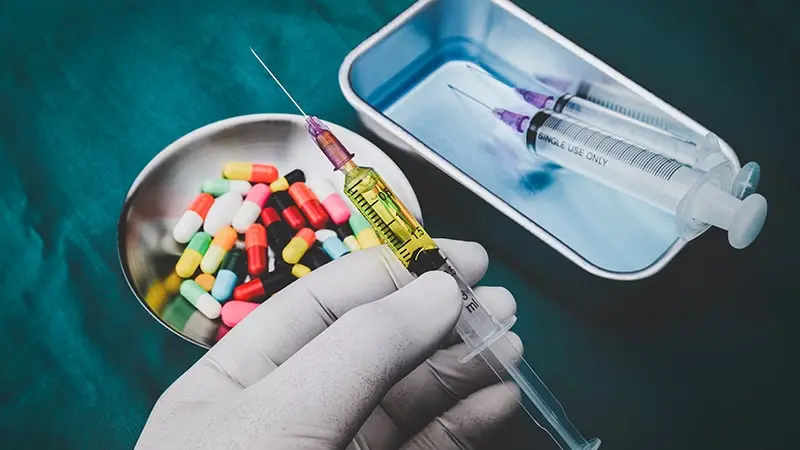Anemia is a medical condition characterized by a deficiency in the number of red blood cells or hemoglobin in the blood, leading to fatigue, weakness, and a host of other health issues. Aplastic anemia, a particularly severe form, occurs when the bone marrow fails to produce enough new blood cells. This can be a life-threatening condition requiring prompt and effective treatment.
Anabolic androgenic steroids, synthetic derivatives of testosterone, have been identified as potential treatment options for certain types of anemia, including aplastic anemia. Compounds such as oxymetholone, danazol, and nandrolone are known to stimulate erythropoiesis—the production of red blood cells. Their use in medicine is carefully regulated due to the potential for serious side effects, but they can be effective in treating anemia when other therapies have been insufficient.
Quick Summary
- Anemia involves a deficiency of red blood cells or hemoglobin, with aplastic anemia being a severe form where the bone marrow fails to produce new cells.
- Anabolic steroids such as oxymetholone, danazol, and nandrolone can stimulate red blood cell production and are used to treat certain types of anemia.
- The use of anabolic steroids in treating anemia should be carefully managed due to potential side effects.
References
Understanding Anemia

Anemia is a condition characterized by a deficiency in the number or quality of red blood cells, which are crucial for carrying oxygen throughout the body. The treatment for anemia varies depending on its cause, which can range from nutritional deficiencies to complex chronic diseases.
Causes of Anemia
The causes of anemia are diverse, and it can develop from several underlying conditions or factors. Nutritional deficiencies are a common cause; they can include a lack of iron, vitamin B12, or folic acid in one’s diet. Chronic blood loss, often resulting from gastrointestinal conditions such as ulcers or certain cancers, can also lead to anemia. It’s important to identify the cause to determine the appropriate treatment.
- Chronic Conditions: Diseases such as kidney failure (renal failure) and some types of cancer can impair blood production, leading to anemia.
- Infectious Diseases: Conditions like HIV and AIDS can also cause anemia, either directly or through associated infections.
- Autoimmune Disorders: These can lead to anemia by affecting blood cells directly.
- Genetic Factors: Certain genetic disorders can result in anemia, including sickle cell anemia and thalassemia.
Prevalence and Types
Anemia can affect individuals of all ages, but it is more prevalent in individuals with chronic diseases and the aging population. The prevalence of anemia is also influenced by socioeconomic factors and access to healthcare. There are several different types of anemia, each with its own causes and characteristics.
- Iron-Deficiency Anemia: The most common type worldwide, often caused by blood loss or inadequate dietary iron.
- Megaloblastic Anemia: Caused by a deficiency of vitamin B12 or folic acid.
- Hemolytic Anemia: Results from the premature destruction of red blood cells.
- Anemia of Chronic Disease: Often associated with chronic conditions like cancer, HIV, and kidney failure.
- Aplastic Anemia: A rare condition where the bone marrow fails to produce enough new blood cells.
References
- “Anemia.” Mayo Clinic. https://www.mayoclinic.org/diseases-conditions/anemia/symptoms-causes/syc-20351360
- “Understanding Anemia — the Basics.” WebMD. https://www.webmd.com/a-to-z-guides/understanding-anemia-basics
Anabolic Steroids Explained

Anabolic steroids are synthetic derivatives of the male sex hormone testosterone, designed to promote muscle growth and enhance physical performance.
Anabolic Vs. Androgenic
Anabolic steroids primarily focus on building up muscle tissue and increasing strength, while androgenic refers to the enhancement of male sex characteristics. The distinction lies in the steroids’ ability to stimulate anabolism, which is the metabolic process that builds larger molecules from smaller ones, as opposed to their influence on androgenic features such as facial hair and a deepened voice.
- Anabolic effects: Increase in muscle mass and strength
- Androgenic effects: Development of male characteristics
Many substances aim for a higher anabolic effect with minimal androgenic side effects. Notable anabolic steroids with such a preferred profile include Metholone and Oxandrolone.
Mechanism of Action
Anabolic steroids mimic the effects of testosterone in the body by binding to androgen receptors within cells. This binding triggers a series of events at the cellular level, which stimulates protein synthesis and promotes muscle growth and recovery.
- Testosterone: Main male sex hormone and natural anabolic steroid
- Hormones: Chemical messengers that regulate body functions
- Sex Hormones: Hormones that control the development of sexual characteristics
Mesterolone and Stanozolol are examples of anabolic-androgenic steroids that can be used to treat conditions like anemia, due to their capability of stimulating red blood cell production.
Anabolic Steroids in Anemia Treatment

Anabolic steroids have been prescribed to stimulate muscle mass and strength, as well as to enhance erythropoiesis, the process which produces red blood cells, thereby potentially treating various forms of anemia.
Therapeutic Use
Anabolic steroids, including agents such as Oxymetholone, Danazol, and Nandrolone, are sometimes used therapeutically in patients with anemia to stimulate erythropoiesis. By promoting the production of erythropoietin—a hormone that increases the production of hemoglobin and red blood cells—these androgens can help address anemia-related symptoms.
Dosage and Administration
The dosage of anabolic steroids in the treatment of anemia varies based on the specific drug and the individual patient’s health status. For instance, Oxymetholone may be administered in doses ranging from 50 to 150 mg per day, while Danazol doses might range from 200 to 800 mg daily, often divided into two doses. Patients must follow a healthcare provider’s prescription closely due to the potential for side effects.
Efficacy of Treatment
The use of anabolic steroids has demonstrated effectiveness in increasing muscle mass and overall strength, along with improving hemoglobin levels and the red blood cell count. For example, Nandrolone has shown promise in enhancing erythropoiesis particularly in patients with renal failure-induced anemia. However, the efficacy can vary and is typically assessed by periodic blood tests to monitor hemoglobin levels and red blood cell count.
References
Frequently Asked Questions

Anemia can lead to severe fatigue and other health complications. Anabolic steroids are sometimes prescribed to stimulate bone marrow, leading to increased red blood cell production in anemic patients. This section addresses common inquiries regarding their use in anemia treatment.
How do anabolic steroids contribute to the treatment of aplastic anemia?
Anabolic steroids stimulate the production of erythropoietin, a hormone that is vital for the generation of red blood cells. In aplastic anemia, these steroids can help to partially compensate for the bone marrow’s inability to produce adequate blood cells.
What are the effects of anabolic steroids on red blood cell production?
Anabolic steroids have been shown to increase hemoglobin and red blood cell concentrations by enhancing erythropoietin secretion and direct stimulation of bone marrow activity, which can benefit patients with anemia.
Can the use of anabolic steroids lead to high red blood cell counts, and how can it be managed?
Yes, using anabolic steroids can result in increased red blood cell counts, a condition called erythrocytosis. To manage this, physicians may adjust the steroid dosage or frequency, or potentially advise therapeutic phlebotomy, where blood is removed to reduce the red blood cell mass.
Are there specific anabolic steroids recommended for treating anemia in adult patients?
Yes, certain anabolic steroids like nandrolone decanoate and oxymetholone are often recommended due to their efficacy in stimulating erythropoiesis. The choice of steroid can depend on the anemia’s cause and the patient’s medical history.
How does oxymetholone therapy impact individuals with anemia?
Oxymetholone therapy can markedly increase red blood cell production in anemic individuals, improving hemoglobin levels and alleviating symptoms associated with anemia, such as fatigue and weakness.
In what ways do anabolic steroids affect the progression of autoimmune hemolytic anemia?
In cases of autoimmune hemolytic anemia, anabolic steroids may be used in conjunction with other therapies to slow the progression of the disease by stimulating red blood cell production, although their role is not as well defined as in other types of anemia.
Dr. Grant Fourie, a specialist in male hormones, is based in Cape Town, South Africa. He provides comprehensive treatments for conditions related to low testosterone, such as erectile dysfunction, fatigue, and mood changes. His methods include hormone replacement therapy and other modern treatment options.
Contact me via email or phone to book personal appointment in my clinic: The Village Square, Cape Town - South Africa



